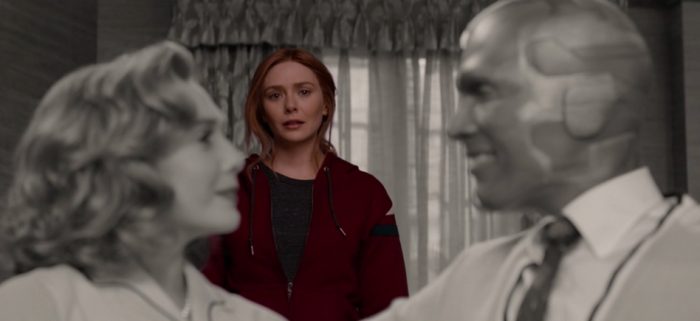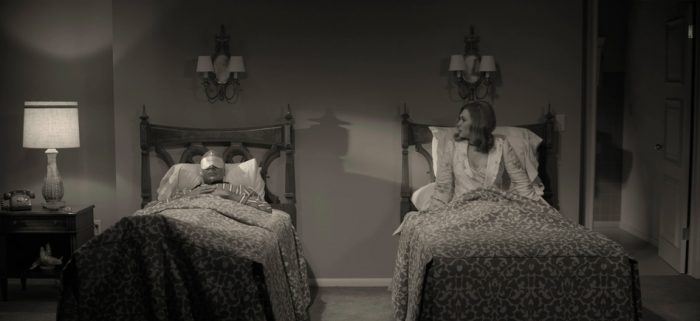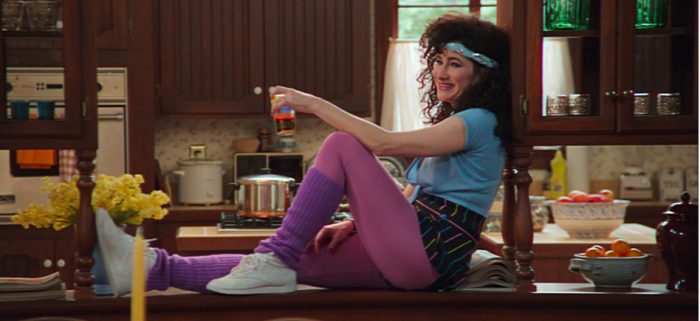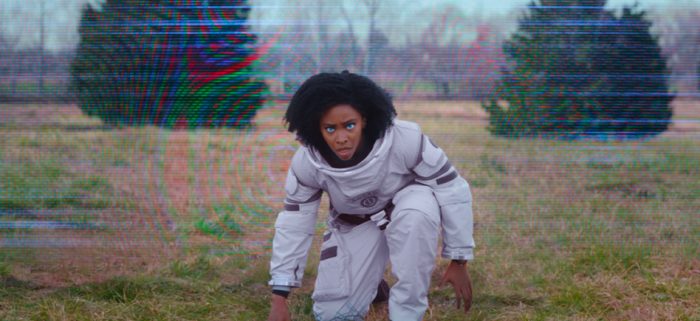What We Talk About When We Talk About ‘WandaVision’: Grief, Trauma, and Fan Theories
The following contains major spoilers for WandaVision.
Living in the Marvel Cinematic Universe must be terrifying. It is a world full of superhuman, god-like beings who answer to no one; a near-Lovecraftian existence where threats from beyond the cosmos are constantly in danger of crashing through and swallowing up everything and everyone. The MCU is a reality where half of humanity can be snapped out of existence – only to return years later to find a world that’s moved on without them. To live in the MCU is to live in a constant state of existential dread. Every now and then, the MCU films will casually address this terrifying truth – and usually shrug it all off with a pithy quip.
Enter WandaVision, a TV series firmly in the MCU that has plenty of jokes and plenty of world-building and fan-friendly Easter eggs – but also plenty of talk about trauma, and grief, and fear, and rage. It dares go to places the movies apparently have no time to visit. But does it do it well? And does any of that even matter in the end?
There’s a word for a highly detailed imaginary world – it’s called a paracosm. Paracosms are complex worlds with their own set of well-established rules. Worlds that don’t actually exist but still feel completely real, especially to the creator. The Brontë siblings had their own paracosms – fantasy kingdoms they created and shared with each other. Middle-earth is a paracosm. So is Terry Pratchett’s Discworld. The list goes on and on, and the causes of paracosms are numerous – boredom and entertainment are at the top.
And then there are less harmless causes – like trauma. “When children experience trauma, they often fall back to a previous stage in their development, they return to a time they felt most safe,” says child psychologist Gwen Aben. “A paracosm is similar, the goal being to step out of reality because it is too difficult to process. Sometimes these imaginary worlds interfere with reality, and they do not know what is real and what is not.”
A paracosm that sprung forth from trauma is at the center of WandaVision, the latest pop culture obsession from the folks at Disney and Marvel. Set after the events of Avengers: Endgame, WandaVision drops viewers into its strange new world without a roadmap. We find super-powered Wanda Maximoff (Elizabeth Olsen) and her android lover Vision (Paul Bettany) suddenly living in a black-and-white sitcom, complete with an audience laugh track. This is weird enough on the surface and gets even weirder when you remember that Vision is supposed to be dead, and there has been no explanation as to how he’s suddenly alive and well again.
As the series progresses, the era – and sitcom setting – changes. The 1950s episode recalls I Love Lucy, The Honeymooners, and The Dick Van Dyke Show; the ’60s brings in references to Bewitched and I Dream of Genie; when Wanda and Vision end up in the ’70s, the look of the show resembles The Brady Bunch, The Partridge Family, and The Mary Tyler Moore Show; the ’80s era brings up Growing Pains, Step by Step, Family Ties, and Full House; the ’90s has Malcolm in the Middle energy; the faux-doc style of The Office and Modern Family invades the 2000s.
The ever-shifting timeline allows WandaVision to break out some not-so-funny jokes (in fact, I’d say not a single intentional joke lands, no matter how gamely the cast tries to sell it) and gives Olsen and Bettany the freedom to flex their acting muscles in ways the Marvel Cinematic Universe films have not. One of the major takeaways here is how badly the MCU has been wasting their talents, with Olsen, in particular, shining as she bounces between bubbly sitcom housewife to something far darker with great agility. To sweeten the deal, WandaVision also brings in the always-welcome Kathryn Hahn, who steals the entire show as Wanda and Vision’s nosy and exuberant neighbor Agnes.
But why is all of this happening? How did Wanda and Vision end up in a small New Jersey town that’s been turned into an ever-changing sitcom? Why is Vision suddenly alive again? Why do certain fellow townsfolk keep acting confused and shifty? Why does a beekeeper suddenly come out of the sewer? What’s up with Agnes? Who is sending mysterious radio broadcasts?
WandaVision gets around to answering these questions, but it takes its sweet time – because at its heart, WandaVision is a mystery box series. The mystery box approach became popularized via a J.J. Abrams TED Talk, in which the filmmaker sang the praises of keeping audiences guessing and how he applies it to his various projects. Lost is the prime example of this, as the entire series was based around a mystery box narrative that kept introducing new twists and turns on a weekly basis. It was a series that pushed fan theories into the mainstream – every week, Lost watchers were offering up their guesses as to just what the hell was going on on that mysterious island, and those theories populated message boards and social media to the extent that they bled into the public consciousness. Because of shows like Lost, fan theories were no longer for super nerds – they were for everyone. Lost didn’t invent the fan theory. But it sure made it popular.
There’s nothing wrong with fan theories. They can result in a shared, communal experience, and they can often lead to fun ideas. But the Lost effect has had detrimental results in how we now consume certain types of media. Over the years, the act of watching Lost-like shows has become all about puzzle-solving. People aren’t so much engaging with the material as they are trying to crack some sort of secret code, as if they were Tom Hanks with a very bad haircut running all over Europe. There appears to be an unspoken belief that if you can just figure the mystery out first, you’ll win some sort of prize. You will have defied the odds and outsmarted the show.
This has been going on for years, but the popular original shows on Disney+ have taken things to the extreme. To their credit, rather than give audiences everything at once, as is customary for streaming entertainment, Disney+ titles like The Mandalorian and now WandaVision have unfolded on an episodic, weekly basis. And such an approach is tailor-made for fan theories – after all, we don’t know what’s going to happen next if we can’t binge a season in one sitting.
The first season of The Mandalorian came and went without such extensive fan theorizing, but season 2 took things in a different direction by introducing a steady stream of characters from other Star Wars adventures. It came to a head with the season finale, in which a digitally de-aged Luke Skywalker showed up to wave around his lightsaber. The Mandalorian had gone from weekly entertainment to a show that had to be decoded. What famous Star Wars figure might show up next?
This approach bled over to WandaVision. It was as if Disney+ watchers were so high off the prospect of surprise character cameos that they expected all Disney entertainment to follow suit. Week after week, people weren’t talking about WandaVision‘s themes, or even its story. They were talking about which mystery might be solved, and which Marvel cameo might break the internet. The prospect of surprise cameos was only heightened when Evan Peters showed up as Wanda’s (dead) brother Pietro Maximoff, aka Quicksilver. The character had the distinction of existing in two separate forms – Aaron Taylor-Johnson played Pietro in the MCU in Avengers: Age of Ultron, while Peters was Fox’s Quicksilver in their X-Men films.
In the Marvel comics, Wanda and Pietro were at one point the offspring of Magneto – a storyline that the MCU couldn’t even touch at first because Magneto was the property of Fox. But in the wake of the Disney-Fox merger, all Marvel characters are under one roof, and fan theories abounded about whether or not Daddy Magneto would suddenly make his first official MCU appearance on WandaVision. “10 Ways WandaVision Can Still Introduce Magneto,” a CBR article helpfully lists. “Magneto will be referenced in WandaVision,” stresses a Reddit thread devoted to Marvel theories.
Eventually, fan theories moved on from Magneto to Doctor Doom. “Marvel Theory: WandaVision Sets Up The MCU’s Doctor Doom,” one ScreenRant article hypothesized. “Did WandaVision Just Drop a Dr. Doom Easter Egg?” asked Comic Book. It didn’t stop there. At some point, someone got it in their heads that the Fantastic Four‘s Reed Richards would make an appearance. There’s currently a Fantastic Four movie in the works at Marvel, but there’s no script in place just yet and no casting has been revealed.
And yet, fandom was convinced a Reed Richards cameo would happen. That theory gained so much traction that it went beyond comic fan-based sites, with more mainstream publications like Forbes claiming, “WandaVision Is Probably Going To Introduce Reed Richards,” and The Wrap asking, “Is WandaVision About to Introduce Fantastic Four Leader Reed Richards to the MCU?” There was even fan casting in play – John Krasinski would play Reed, and WandaVision would introduce him by referencing The Office, the series that turned Krasinski into a star.
There was absolutely no evidence that anything like this would happen in WandaVision, and yet the theory dominated social media. So much so that when it didn’t happen, Syfy published an article stating that fans were “let down” when John Krasinski’s hypothetical Reed Richards failed to materialize, complete with a stream of Twitter reactions. Perhaps anticipating all this fan theorizing is getting out of hand, WandaVision director Matt Shakman appeared to try to tamp down the hype by saying of the approaching season (and maybe series) finale: “I know there are so many theories out there; there will be a lot of people who will no doubt be disappointed by one theory or another. But we’re always telling this story about Wanda dealing with grief and learning how to accept that loss, and hopefully, people will find that the finale is surprising but also satisfying and that it feels inevitable because it’s the same story they’ve been watching the whole time.”
Again: there’s nothing wrong with fan theorizing, and I certainly don’t fault any of these publications for running articles about it. Publications live and die by clicks, and this type of theorizing is what brings those clicks in. But there has to be more to the conversation. Surely this can’t be the only way we consume and digest pop culture entertainment, right? There’s more going on in WandaVision than mysteries…isn’t there? The conversation abruptly shifted with the release of the penultimate episode, “Previously On.” This episode was essentially an exposition dump from start to finish, filling in all the blanks while trying to pack a big emotional punch. It seemed to be successful on that later front, particularly when Bettany’s Vision delivered an admittedly powerful line, asking Wanda, “What is grief, if not love persevering?”
People took to social media to talk about how much the episode, and that line in particular, moved them to tears. And yet there was also a swift backlash, with many shrugging such moments of sentimentality off as cheap and unearned. Yes, the line is touching – but why did it take so long for WandaVision to reveal it? And that, perhaps, is why so much talk about WandaVision has been devoted to guessing what comes next rather than what’s actually going on. On paper, this is a show about a fantasy world that has been materialized because of grief and trauma, but WandaVision is so beholden to its formula that it has a hard time getting such a bold idea across. Instead, it’s tried to take a shortcut and turn grief and trauma into mystery box elements.
There are hints of these weighty themes lurking in the margins. When things go haywire in the neighborhood, Wanda asks, “Do you think they know it’s my fault?”, with particular emphases on the last two words. When Pietro shows up and asks Wanda about a childhood memory she can’t remember, he says: “You probably suppressed the trauma.” When Wanda is giving an Office/Parks and Rec/Modern Family-style direct-to-camera interview about everything going very wrong, she’s asked: “Do you think maybe this is what you deserve?” Even the jokey commercials play into Wanda’s regret – like when a commercial for Lagos paper towels recalls the Lagos Catastrophe in Captain America: Civil War. “Lagos: for when you make a mess you didn’t mean to!” the ad copy announces – as if trying to absolve Wanda of lingering guilt.
It’s not subtle, but the problem is it feels like it’s trying to be subtle, or at least play coy. By playing Wanda’s fractured mindset as some sort of spoiler element, WandaVision hampers its effectiveness. It’s made all the more maddening by the fact that we already know Wanda has suffered plenty of trauma and grief. Her parents were killed before her eyes. Her brother was killed later. During the events of Avengers: Infinity War, Wanda was forced to kill Vision herself – only to see him reanimated and then killed again. Girl’s been through a lot; it’s no wonder she’s in the midst of what could be a depersonalization-derealization incident and escaping into the classic sitcoms she watched with her family as a child.
And yet, WandaVision waits until its second-to-last episode to “reveal” all of this. We’re treated to a barrage of flashbacks that are meant to fill in the blanks, but having these flashbacks stacked on top of each other robs them of having real power – even though Olsen does a great job trying to sell them. Not to mention that the episode before “Previously On,” titled “Breaking the Fourth Wall,” attempts to subvert these revelations with the super amusing, highly-catchy “Agatha All Along” reveal. Here we’re lead to believe that Kathryn Hahn’s Agnes is actually Marvel witch character Agatha Harkness and that she’s to blame for all the show’s shenanigans.
But she’s not – Wanda is really doing most of the heavy lifting here, and “Previously On” makes this clear almost immediately. So what, then, was the point of “Agatha All Along”? That’s not even addressing the problem that WandaVision treats Agatha’s name reveal as some sort of shocking twist. “The name’s Agatha Harkness!” she proudly proclaims, and the line delivery is done in such a way that the audience – and Wanda – is supposed to know who the hell that is. It’s the same goofy mistake that J.J. Abrams’ Star Trek Into Darkness made with its reveal that Benedict Cumberbatch was secretly playing Khan. “My name is Khan!” Cumberbatch announces triumphantly midway through the story, but in the timeline of the movie, the crew of the Enterprise has no idea who the hell Khan is or why he’s supposed to be a big deal. Sure, Star Trek fans will know, but so what? It’s lazy fan-service in the name of creating a big, shocking mystery box moment.
Harming things further is that Wanda and Vision often feel like supporting players in their own story. Time and time again, WandaVision will cut to the outside world to focus on Monica Rambeau (Teyonah Parris), a member of the S.H.I.E.L.D. substitute S.W.O.R.D., as she tries to get to the bottom of things, working with Randall Park as FBI Agent Jimmy Woo (fun!) and Kat Dennings as comic relief astrophysicist Darcy Lewis (annoying!).
Parris’s performance is quite good, and her storyline does give us a powerful, haunting flashback moment where we see Monica return to the world years after being snapped (or blipped, as I guess the MCU is officially calling it) out of existence by Thanos, only to find that her mother is long dead. This storyline exists to show that Monica knows a thing or two about grief and trauma and can therefore relate to what Wanda is going through. But it also distracts from Wanda and Vision’s story, as does the fact that we can see through it all and realize that the real reason it’s even part of the show is so that WandaVision can tie more directly into the overarching MCU story (and set up future movies). I dare you to tell me why the S.W.O.R.D. stuff even matters to this show. Hell, I dare you to give me the name of the boring, somewhat villainous S.W.O.R.D. director Monica keeps clashing with without looking it up.
This all goes a long way toward making WandaVision feel somewhat cheap, taking the easy way out rather than drilling down on its weightier themes. It’s a problem that extends to the MCU as a whole. And you know what? That’s understandable – Disney and Marvel are ultimately trying to entertain people here and sell some brightly-colored Funko Pops in the process, not send viewers into an existential spiral. But there’s something potentially powerful about pop entertainment going the extra mile, and I wish WandaVision would try just a little harder to go there. Crack open the mystery box sooner and not worry so much about big shocking twists and MCU tie-ins.
Whatever you want to say about Lost and its mystery box approach, it never sacrificed character building and emotional heft for the mystery. The consistent flashback format of the show helped us learn exactly who the characters were and what motivated them. Imagine if WandaVision had taken a similar approach – sprinkled in these revealing flashbacks in earlier episodes instead of maintaining one big mystery. As WandaVision comes to an end, it will no doubt drop more big twists and break out my shocking reveals, all in the name of setting up what comes next. And in a few weeks, we’ll have all moved on. After all, The Falcon and the Winter Soldier premieres this month, and there will be plenty of new fan theories to obsess over. And when that’s over, it’ll be time to move on to Loki.
None of this is to say that WandaVision‘s story about the emotional and psychological distress and need for escapism wrought by grief is ineffective. Indeed, for many, the show resonates. After all, we are a world currently awash in almost unimaginable grief. As WandaVision nears its season finale, we are coming up on a full year of COVID-19. There have been 2.53 million deaths worldwide, and 514,000 in the United States alone. WandaVision is a story of someone emotionally devastated by a world of death escaping into a world of harmless entertainment, and who among us can’t relate to that right now?
A year ago, we entered the pandemic era with an almost naive optimism; we were going to take up hobbies; we were going to have Zoom get-togethers; we were going to applaud essential workers at certain times of day. We were going to get through this. Now, as the calendar rolls back over to March, there’s the faintest glimmer of hope – but it comes after great loss, and with the realization that nothing will ever be the same again. It can often feel as if there is no real relief. No end in sight. No escape. That almost surreal grief is like an open wound; a cavity in the back of our mouths that we keep running our tongue over even though we know it might send out an electric shock of pain. The escapism of WandaVision is exactly what some people need right now, and there’s no harm in that. But wouldn’t it be nice to have something more? WandaVision is a step in the right direction for the MCU. It would just be nice if they took a few more steps further.
The post What We Talk About When We Talk About ‘WandaVision’: Grief, Trauma, and Fan Theories appeared first on /Film.
from /Film https://ift.tt/3kIt12o




No comments: